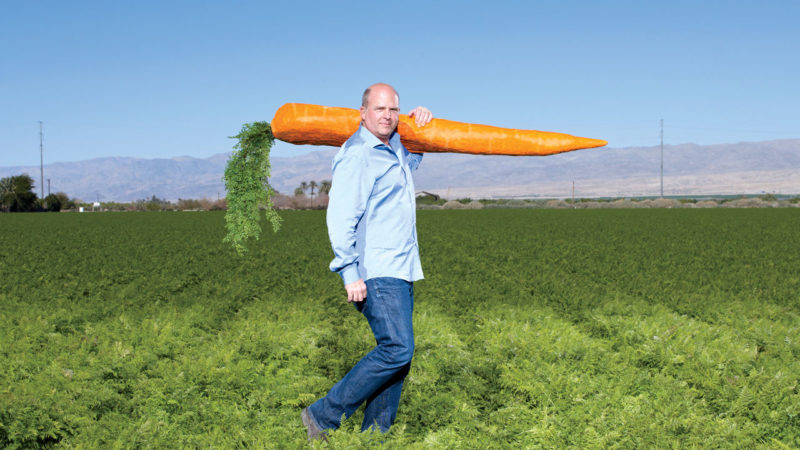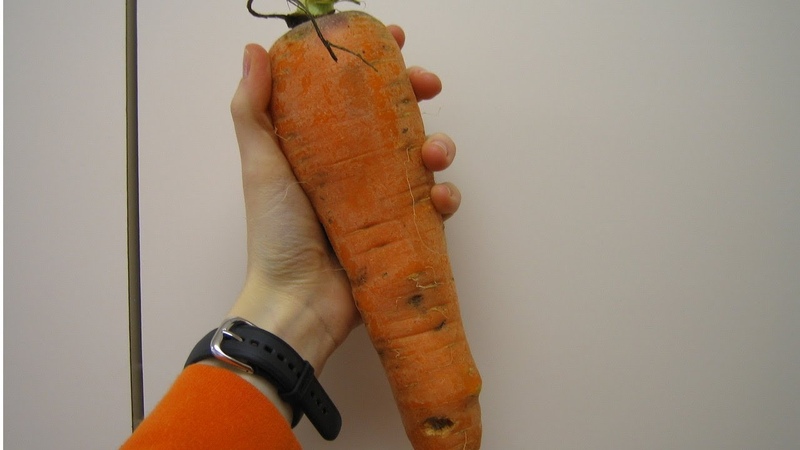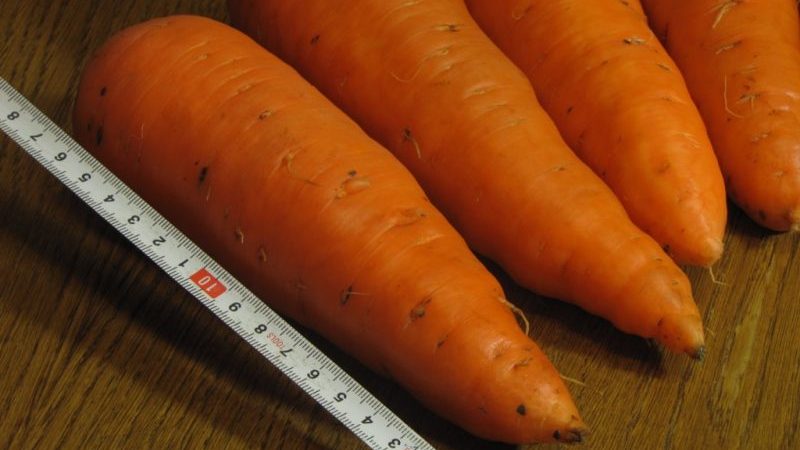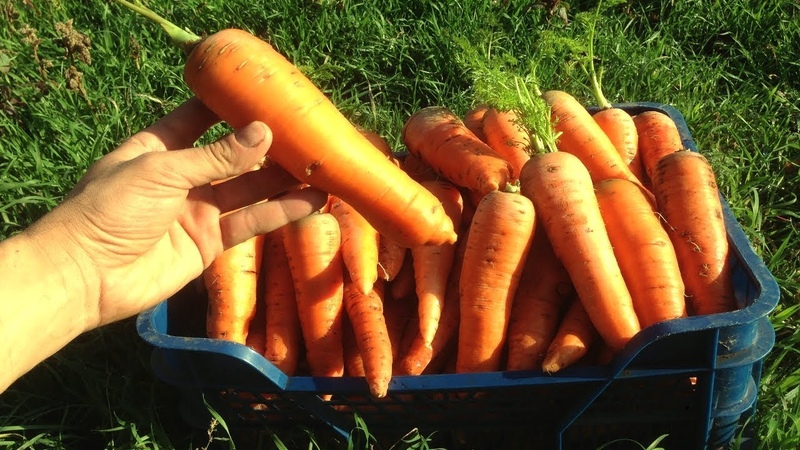Record holders among vegetables: what is the largest carrot in the world and who grew it
Carrots are successfully grown in 76 regions of Russia. Despite the unpretentiousness of this vegetable, it is not always possible to get a rich and high-quality harvest. However, this business has its own champions, whose achievements cause not only respect, but also surprise.
Consider which variety is better to choose and what nuances to take into account when growing in order to enjoy the taste of large and juicy root crops.
The content of the article
Ranking of the largest carrots in history
A standard carrot, bought in a store or grown in a garden, weighs about 70-160 g and is 10-15 cm long.
However, some gardeners managed to grow root crops of impressive size, which made it into the Guinness Book of Records.
The biggest
The weight of the largest carrot in the world is 10.18 kg. It was raised by American farmer Christopher Qualley in 2017. This is 1 kg more than the previous record of Peter Glazebrook, which was recorded 3 years earlier.

The longest
The longest carrot measures 6.2 m.It was grown by Briton Joe Atherton in 2016. The man broke his own previous record.
Interesting! This result was achieved thanks to a special technique in which the seeds are planted in long tubes with compost.
Records in Russia
There are no such records in Russia for carrot cultivation yet. However, EI Shornikova, a resident of the city of Vyksa, Nizhny Novgorod region, managed to get a root crop of solid size (weighing 2.18 kg).
The largest-fruited varieties and hybrids

Large varieties are considered those whose mass exceeds 200 g, regardless of size.
Russian size
This mid-season variety ripens in 110-115 days from the date of germination. On light soils, root crops grow up to 30 cm in length, weighing up to 1 kg. The vegetables are smooth, bright orange with blunt tips, sweet and juicy in taste.
Planting period - April - May. The culture is suitable for growing in the middle lane.
Vita Longa
Mid-season variety, bred by a Dutch firm. It takes up to 160 days from sowing seeds to harvesting. The length of root crops reaches 30 cm, weight - 300 g. Plants are resistant to pests, grow in heavy soil, suitable for industrial cultivation.
Productivity is high: up to 490 kg / ha. Vegetables are stored for 7-8 months.
Canada F1

Medium late hybrid from Holland, which has a high yield (up to 630 c / ha) and good keeping quality (until April). Suitable for growing in all regions. The length of carrots is about 20 cm, the average weight is 180-200 g, some specimens grow up to 400 g.
Sowing period - late April - early May. Canada F1 grows even on clay soils or shaded areas, but does not tolerate excessive soil moisture.
Autumn king
Medium late grade, 110-120 days pass from sowing to harvest. Recommended for growing in the Central and Central Black Earth regions. The length of carrots reaches 29 cm and weighs 100–250 g. The flesh is juicy, crispy and sweet.
Productivity from 1 m2 - 5-6.5 kg. The culture cannot stand waterlogging.
Shantane
Variety type Shantaneoriginally from France, grown in Russia since the middle of the 20th century. The most popular variety is Shantane 2461. This is a mid-season carrot with a growing season of 100–130 days, depending on the growing region.
The length of the roots reaches 25 cm, and the weight is 150-200 g. The shape of the vegetables is conical, the color is bright orange.The pulp is juicy and sweet, the sugar content is 5-10%. The variety grows well on any type of soil, does not crack at high humidity and gives a good yield (from 5.5 to 9 kg per 1 m2).
Reference! The ripening period of carrots depends on the climatic characteristics of the region in which they are grown.
Nantes 4
Mid-season variety, harvest ripening period: 70-100 days. Carrot length - 14-16 cm, weight - 100-170 g.
Root crops are valued for their excellent taste, thin core and good yield (7 kg per 1 m2). The vegetable is grown throughout Russia.
Amsterdam
This early ripe variety fully matures in 90 days. The size of root crops is 15–20 cm, weight - up to 170 g.
Carrots have a regular cylindrical shape and good taste. Marketable yield - 208–463 kg / ha. The culture is resistant to diseases and high soil moisture.
How to grow a record carrot

According to Christopher Qualley, who set the world record for growing giant carrots, the main conditions for success are soil quality, the right variety and weather conditions.
Tips and Secrets
Let's consider the recommendations of experienced farmers in more detail:
- When choosing a variety, ripening terms, keeping quality, zoning are taken into account.
- Seeds are bought in branded packaging, which contains information about the variety, cultivation characteristics, shelf life and manufacturer.
- The root crop grows well in evenly lit, flat areas. Suitable predecessors and neighbors: squash, pumpkin, potatoes, tomatoes, onions. Do not plant carrots after dill, parsley, fennel, do not grow 2 years in a row in one place.
- Carrots are demanding on the looseness of the soil. Sandstones, peatlands and loams are ideal for crops. Before planting, the soil is dug deeply, loosened with a rake, if necessary, sand is added at the rate of 1 bucket per 1 m2. The seeds are not planted in fresh manure: this will spoil the taste and shape of the vegetables. Fertilize the soil in autumn and spring, 2-3 weeks before planting.
- Carrots are sown when the topsoil (10-15 cm) warms up to + 8 ° C.
- The distance between the rows is maintained at 15–20 cm, and between the plants - at least 4 cm. After 3 leaves appear, weak and underdeveloped shoots are removed.
- The culture is fed 3-4 times throughout the growing season. An excess of nitrogenous fertilizers negatively affects the quality of carrots, and potassium improves its taste, since it contributes to the accumulation of sugars. The first feeding is carried out 3-4 weeks after germination, the subsequent ones - 2-3 weeks after. They use potassium magnesium (a source of potassium, magnesium and sulfur), phosphorus-potassium mixtures, and ash.
- In the first month after planting, vegetables are watered 2-3 times a week. During the period of active growth of the culture, the soil is moistened 1 time in 7-10 days. After irrigation, the soil is mulched. Watering is stopped 3-4 weeks before harvesting.
In order not to carry out thinning, they practice planting carrots on a tape.
Reviews

Experienced gardeners willingly share not only their accumulated experience in growing root crops, but also their opinions on the relative varieties:
Ekaterina Luzhkova, Pavlodar: “Canada F1 is a great hybrid. Even on clogged soil, it gives a good harvest. I plant it after harvesting cabbage. The ground after it is usually dense, and carrots at least that! "
Ulyana, Smolensk: “The germination rate of Nantes is good, the crop ripens quickly. The carrots are sweet and juicy. Mostly vegetables are large with blunt ends. "
Ekaterina, Saransk: "I was convinced last year that the Autumn King variety is stored in winter almost until the end of April without losing its taste. Therefore, this season I planted only him in the beds. ".
Conclusion
Large-fruited varieties of carrots are mainly medium and late ripening, suitable for long-term storage. To get a rich harvest, it is important not only to choose the right variety, but also to observe the peculiarities of planting, to ensure proper care of the crop. This will reduce the risk of disease and pests.